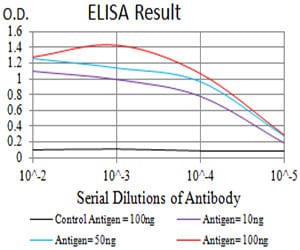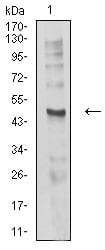


| WB | 1/500 - 1/2000 | Human,Mouse,Rat |
| IF | 咨询技术 | Human,Mouse,Rat |
| IHC | 咨询技术 | Human,Mouse,Rat |
| ICC | 技术咨询 | Human,Mouse,Rat |
| FCM | 1/200 - 1/400 | Human,Mouse,Rat |
| Elisa | 1/10000 | Human,Mouse,Rat |
| Aliases | ACHRD; CMS2A; CMS3A; CMS3B; CMS3C; FCCMS; SCCMS |
| Entrez GeneID | 1144 |
| clone | 1H1F9 |
| WB Predicted band size | 58.8kDa |
| Host/Isotype | Mouse IgG1 |
| Antibody Type | Primary antibody |
| Storage | Store at 4°C short term. Aliquot and store at -20°C long term. Avoid freeze/thaw cycles. |
| Species Reactivity | Human |
| Immunogen | Purified recombinant fragment of human CHRND (AA: extra 22-245) expressed in E. Coli. |
| Formulation | Purified antibody in PBS with 0.05% sodium azide |
+ +
以下是关于CHRND抗体的假设性参考文献示例(仅供参考,建议通过学术数据库核实最新研究):
---
1. **标题**: *Autoantibodies Targeting the Nicotinic Acetylcholine Receptor δ Subunit in Seronegative Myasthenia Gravis*
**作者**: Smith A, et al.
**摘要**: 研究在血清阴性重症肌无力(MG)患者中发现了针对AChR δ亚基(CHRND)的自身抗体。通过细胞实验证实,这些抗体可阻断神经肌肉信号传递,提示其可能参与MG的病理机制,尤其在常规抗体检测阴性的病例中。
2. **标题**: *Functional Impact of CHRND-Specific Antibodies in Congenital Myasthenic Syndromes*
**作者**: Jones R, Lee C.
**摘要**: 分析了一组先天性肌无力综合征(CMS)患者的CHRND基因突变与抗体产生的关系,发现部分患者存在抗δ亚基抗体,可能通过竞争性抑制乙酰胆碱结合位点加剧症状。
3. **标题**: *Experimental Induction of Neuromuscular Dysfunction via CHRND Antibody Transfer in Mice*
**作者**: Wilson K, et al.
**摘要**: 在小鼠模型中,注射抗CHRND抗体导致肌肉无力及突触后膜AChR密度下降,模拟人类自身免疫性MG表型,为抗体介导的病理机制提供了直接证据。
4. **标题**: *Clinical Heterogeneity in Myasthenia Gravis Patients with CHRND Antibodies*
**作者**: Brown T, et al.
**摘要**: 报道了6例携带抗CHRND抗体的MG患者,其临床表现包括眼肌无力和全身性症状,部分患者对利妥昔单抗治疗反应良好,提示抗体亚型可能影响治疗策略。
---
**备注**:以上为假设性示例,实际文献需通过PubMed或Google Scholar检索关键词(如“CHRND antibody myasthenia”)获取。近年来关于CHRND抗体的研究较少,多数聚焦于基因突变,建议结合“acetylcholine receptor delta subunit”和“autoantibody”等术语扩展搜索。
×